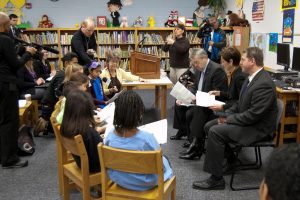Governor Releases Education Reform Plan at Visit to Capitol View

Governor Branstad, Lt. Governor Reynolds and Education Director Glass - along with members of the news media - with 3rd graders in the Capitol View library.
Iowa Governor Terry Branstad visited Capitol View Elementary School this morning to announce his legislative proposal for education reform in the state. The Governor was joined by Lt. Governor Kim Reynolds and Iowa Department of Education Director Jason Glass on his visit to Capitol View, where they also watched a brief performance by the 3rd grade reader’s theater.
A month ago, Governor Branstad and Lt. Governor Reynolds held a town hall meeting at Central Campus – attended by more than 150 parents and teachers – to discuss the preliminary version of their education reform proposal.
The Governor said his proposal – estimated to cost $25 million to implement – is directed at educator effectiveness, student expectations, and school innovation. One proposal made by the Governor is that the Iowa Tests of Educational Development (ITED) would be phased out for 11th grade students and replaced by a college entrance exam; DMPS already provides the ACT exam to all high school juniors.
NOTE: To see photos of the event, be sure to visit our Flickr page here.
Below is a copy of the press release issued by the Governor’s office, which includes a link to a complete copy of the Branstad-Reynolds Administration’s legislative proposal:
BRANSTAD-REYNOLDS ADMINISTRATION UNVEILS FINAL RECOMMENDATIONS FOR WORLD-CLASS SCHOOLS
(DES MOINES) – Gov. Terry Branstad and Lt. Gov. Kim Reynolds today released their final recommendations for restoring Iowa’s standing as a leader in education and preparing all students to compete for jobs in a global economy.
The document represents an overview of proposed education legislation that will be presented by the Governor and Lt. Governor in the 2012 session.
The recommendations stay true to three key areas outlined in a blueprint for education reform released by the Branstad-Reynolds administration in October: highly effective teachers and leaders, high expectations for all students with fair measures for results, and innovation that boosts learning.
“Iowans have played a critical role as we’ve worked to elevate the conversation about improving our schools,” Branstad said. “These proposals will put us on the path to make Iowa schools among the best in the world.”
World-class schools are one of four top priorities set by Branstad and Reynolds. The administration has worked for the past year to carve out a long-term, reform-minded policy direction that builds from Iowa’s strengths and adopts improvements with lessons learned from the highest-performing systems in the world.
In July, the Branstad-Reynolds administration convened an education summit to discuss ideas about what it takes to lead the world in education.
As part of the summit, the Iowa Department of Education released a report, “Rising to Greatness: An Imperative for Improving Iowa’s Schools.” The report documented Iowa’s stagnation in math and reading competency compared to other states and nations.
The education blueprint released in October was a starting point for meaningful change. Members of the Branstad-Reynolds administration traveled the state last fall to listen to ideas at dozens of town hall meetings.
One change made as a result of input from Iowans: Doing more, beginning in preschool, to help students read by the end of third grade. At that point, most students go from “learning to read” to “reading to learn.” Students who finish third grade without meeting basic literacy requirements across a broad set of measures would be retained and provided intensive reading assistance.
Another change adds state standards for music and other fine arts, applied arts, physical education, character education and entrepreneurship education.
“We all share a common goal of giving our students a first-rate education,” Reynolds said. “We look forward to engaging Iowans in this ongoing discussion as we work together to find the best solutions for our state.”
Key proposals include:
- Be more selective about who can become an educator by requiring a 3.0 grade-point average to gain admission into teacher preparation programs.
- Candidates for teaching licensure must pass a test demonstrating content-specific and teaching knowledge.
- Evaluate teachers annually instead of every three years, which is the current requirement. Principals and superintendents also would be evaluated each year.
- Widen the pathways to alternative teacher licensure with a number of quality assurance checks.
- Make seniority a minor factor in deciding which teachers are laid off by a school district faced with reducing the workforce. Annual evaluations based on performance should be the main factor.
- Establish state task forces to study important long-term issues, such as teacher leadership, compensation and questions about extending the school day or school year.
- Give all preschool students and enrolled 4-year-olds a kindergarten readiness assessment to determine early literacy and numeracy skills.
- High school students will take end-of-course exams in core academic areas of algebra, English, science and U.S. history to make sure they have a solid foundation before they graduate and to better align high school courses to the Iowa Core.
- All 11th grade students take a college entrance exam as a way to provide one of the keys needed for postsecondary education. Phase out the current 11th grade assessment, the Iowa Tests of Educational Development.
- Eliminate requirements around seat time for academic credit to accommodate school districts that choose to adopt a system of competency-based education, which advances students based on their mastery of subjects.
- Widen the pathway for starting charter schools by giving the State Board of Education authority to approve charter applications from universities, community colleges and nonprofit organizations, as well as collaborative efforts of all these groups. Iowa’s current charter school law is restrictive in that it only allows existing school districts to establish charter schools.
- Give school districts greater flexibility to meet state requirements so that public schools can better apply innovative ideas to improve learning. School districts would have the same flexibility that charter schools have.




